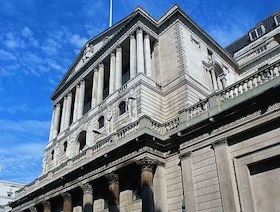The Bank of England said it expects the economy to shrink by 9.5% in 2020, less than the initial estimate of 14%.
The 9.5% predicted in the first official forecast since the Coronavirus pandemic lockdown would still be the largest annual decline in 100 years.
The Bank also warned that the job market recovery would take longer with leisure spending and business investment staying subdued. It expects the economy to grow by 9% in 2021 and 3.5% in 2022.
Unemployment is expected to rise to 7.5% by the end of the year as the government-funded furlough scheme comes to an end.
The economy is expected to recover pre-lockdown levels by the end of 2021.
The Bank's forecasts came as its Monetary Policy Committee decided to hold interest rates today at 0.1%.
The Bank noted that its latest forecasts were dependent on the continued easing of national lockdown measures and a smooth transition to a new EU free trade agreement in 2021.
Investment platform AJ Bell shared concerns that we could still see negative interest rates in 2020 should we see a second wave of the Coronavirus hit the UK.
Laura Suter, personal finance analyst AJ Bell, said “Any interest rate rise has been ruled out by the rate setters for the foreseeable future, with the Monetary Policy Committee unanimously voting to keep rates at the current 0.1%. They indicated that they have no plans to change either rates or the current asset buying programme until spare capacity is being eliminated.
“The Bank now forecasts that UK GDP will return to its 2019 levels by the end of next year, meaning it’s expecting two lost years of growth for the UK.
“However, the bank paints a bleaker picture on the outlook for employment and business spending and cautions that the UK’s future is ‘unusually uncertain’ thanks to the continued spread of the Coronavirus. What’s more, it expects inflation to fall back after a rise in July and hover around the 0.25% mark later this year. Worries about a second wave of Covid-19 mean the economic outlook is particularly uncertain and that negative interest rates can’t be ruled out. Any rate rise is miles away and savers will continue to see paltry returns on their cash.”
Fund management giant Fidelity said that this latest forecast means that recent preference for gold by investors looks set to continue as well as the struggle to search for yield.
Tom Stevenson, investment director for personal investing at Fidelity International, said: “It is the medium term picture that is most sobering. The recovery in demand will take time as health concerns persist and the risks to the outlook are clearly weighted to the downside now.”

